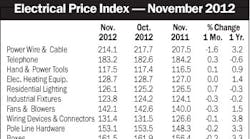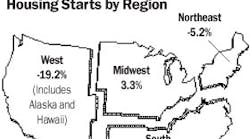Latest from Mag
When you strike up a conversation about mergers and acquisitions in the electrical market, most people immediately start rambling about consolidation of the electrical channel and the hundreds of family-owned electrical supply houses that have been acquired by larger national or regional distributors over the past several decades.
But in recent years, electrical manufacturers have been busy acquiring companies, too. A feature article, “They Must Be Giants,” that will be published in this month’s issue of Electrical Wholesaling will take a closer look at these acquisitions to offer see what impact they are having on the electrical market right now and how they may reshape the business in the future.
Over the past five years, EM has reported on more than 100 acquisitions, including those that involve well-known electrical companies such as: American Power Conversion (APC), West Kingston, R.I. (Schneider Electric, 2006); Baldor Electric, Fort Smith, Ark. (ABB Inc., 2010); Burndy, Manchester, N.H. (Hubbell Inc., 2010); Carlon, Cleveland (T&B, 2007); E-Mon, Langhorne, Pa. (Honeywell, 2010); the building wire division of Essex Electrical Products, Fort Wayne, Ind. (Southwire, 2005); Genlyte Group, Louisville, Ky. (Philips, 2007); and Tork Inc., White Plains, N.Y. (NSI Industries, 2006). Many of the biggest acquisitions are being made by the same electrical manufacturers, and very often in the same product categories (see chart below). Here are the product areas that have seen the most acquisition activity.
Ever-more efficient lighting. It probably comes as no surprise to anyone who has been splattered by all the green ink in industry trade publications that the lighting market is one of the most active arenas for acquisitions, particularly in the rapidly growing LED niche. In his blog, “The Buzz,” Ted Konnerth, owner, Egret Consulting, Mundelein, Ill., reported that at this year’s Strategies in Light conference held in Santa Clara, Calif., the word was that sales for LEDs in commercial lighting applications would grow from $900 million in 2010 to $4.5 billion in 2015 – a 39-percent annual growth rate.
Wrapped up in miles of wire and cable. Distributors, manufacturers and reps have been on a wild ride with copper pricing over the past few years. Adding to this turbulence has been a bevy of high profile-acquisitions that included at least 15 separate deals. The biggest of them all — in fact the largest acquisition affecting the electrical market over the past five years — was the 2006 deal where Freeport-McMoRan Copper & Gold, Phoenix, bought Phelps Dodge for $25.9 billion (yes, that’s “billion” with a “b”), creating the world’s largest copper producer.
The nuts-and bolts of data centers. As one of the few active segments of the commercial construction market, data centers are attracting a steady stream of new players that want to get in on the action, or existing players that want to build up their businesses in this niche. Look for more acquisition activity in the data center market. The commercial construction market has been an absolute train-wreck in recent years, but one area that has shown through as a beacon of hope has been data centers. Worldwide demand for data centers is expected to rise 12 percent this year, 14 percent in 2011 and 17 percent in 2012, according to Tier1 Research.
Powering up in the motor market. In the past five years, there’s been more than $7.3 billion in motor acquisitions, including two multi-billion dollar deals involving the same company — Baldor Electric Co., Fort Smith, Ark., which bought Rockwell Automation’s Reliance Electric motor business in 2006 for $2.25 billion. Five years later ABB, Switzerland, bought Baldor for $4.2 billion. Also in the motor news has been the acquisition earlier this year by Regal Beloit, Beloit, Wis., of A.O. Smith, Milwaukee, for $875 million. The motor market will be an interesting product segment to watch down the road. There will continue to be a big push for energy-efficient motors from NEMA’s Premium Motor program, federal efficiency standards, utility-rebate programs, and the overall interest in green electrical products.
The brains behind the smart grid. If you want a dollars-and-cents indications that electrical manufacturers believe the utility smart grid is for real, look no further than the dollar value of the acquisitions of manufacturers or suppliers of the complex software and supporting electrical and electronic products that will control the smart grid.
It’s been one of the most active acquisition arenas over the past few years. Lux Research says this market will grow from $12.8 billion this year to more than $30 billion over the next decade. The consulting firm also believes global giants like ABB, GE Energy, Siemens and Schneider and electric utilities will spend more than $20 billion by 2020 on smart-grid technologies.
— Jim Lucy

